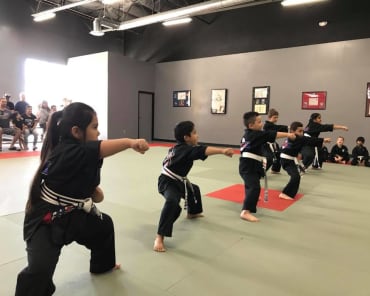
6 Martial Arts Myths and the Truths Behind Them
The martial arts world is home to an awful lot of myths, misconceptions, half truths and sometimes even outright lies. Most of this comes from well meaning individuals – including well trained martial arts instructors – who are merely repeating what they’ve been told. Only a small portion of it is malicious, coming from hucksters and scam artists hoping to part people from their hard earned money. Even so, all of it is damaging – not just to those who are fooled, but to the martial arts community as a whole.
The selection below is just a very few of the martial arts myths that I’ve encountered over the years. As you can see, most of these myths are based on some small nugget of truth that has been expanded and twisted into a dangerous form.
Myth 1 – Super Secret Ancient Knowledge of Awesomeness
To hear Hollywood – and some martial artists – tell it, the only martial arts worth knowing are the ancient, secret styles taught by monks hidden away in fantastical mountains who never teach their mysteries to outsiders. The older and more pure a martial art is, the better. The fewer people who have studied it, the better. The less well known it is, the better. And all modern martial arts are just “watered down” versions of these ancient secrets.
Truth: Go ask the US Army if the oldest “martial” fighting systems are the most effective. That noise you here is their laughter. What was that? You can’t hear it over the roar of a cruise missile or the whump-whump-whump of an Apache attack helicopter? Yeah, me either. But trust me, it’s there.
The truth is that combat is always evolving. The oldest and most ancient martial arts began when a caveman picked up a stick and whacked another caveman over the head with it. Honestly, it probably began even before he figured out to use the stick. If we went back to the “oldest” system, it would be that simple.
There is a bit of truth to the idea of secret styles. They do exist. In fact, most martial arts styles were highly secretive up until about the 19th century. Until gunpowder revolutionized modern warfare (and remember – Japan was completely isolated until the 1890s, so this took a lot longer there), what we know now as the formalized martial arts were closely held military secrets. You didn’t let them out because you didn’t want your enemies to use them against you.
In this day and age, though, many of the secret arts have been aired to “the public” – meaning that they’re accepting students outside their secret clans, not necessarily that all the info is on YouTube. Outside experts have had a chance to study the once hidden styles. And although they’re often effective, they’re not anything particularly more effective than the less secretive styles. There are only so many ways the human body can move, and at this point in human history we’ve studied most of them quite well.
Nevertheless, some of these older and ancient arts can be a lot of fun to learn and can still have utility in the modern age. There’s nothing at all wrong with studying them. Just don’t expect them to be amazingly superior to other arts.
Myth 2 – Strength Training Will Make You Slow as a snail.
I’ve heard this one a million times from martial artists. The argument goes something like this: “I don’t do weight training because weight training makes you big and bulky and that makes you slow.” The raw ignorance of this argument makes me groan every time.
Truth: being big doesn’t make you slow. Being fat makes you slow. More muscle will make you faster. And stronger. And you’ll take a hit better. In short, for the martial artist there is NO downside to strength training. It will improve your martial arts in every way.
Some out there will even try to claim that strength training has to be done “right” to benefit martial artists. Specifically, they’ll say that you have to focus on “explosive power” rather than strength. There’s no doubt that this is the best way for martial artists to strength train. But almost any basic strength training program will benefit you, even if it’s less than perfect. Don’t let the perfect be the enemy of the good. Consider incorporating free weights into your training regimen today.
Myth 3 – All Fights Can Be Ended With a Hug and a Song
OK, technically speaking this myth doesn’t usually come from martial artists. It comes from others outside the community who think that all of life’s problems can be solved by sitting around a campfire singing “Kumbaya.” They live delusional lives in a make believe Cloud cuckoo land in their heads.
Truth: Most fights actually can be avoided – and that’s exactly what we encourage our students to do. Avoiding the fight altogether is the best way to defend yourself. The simplest ways to do this are to avoid trouble areas (your local police can tell you where the high crime areas are; these days they might even have it online) and keep your wits – and your calm – about you.
But there are people out there who, for one reason or another, want to hurt you. And they aren’t always so thoughtful as to keep themselves pent up in predictable “bad areas of town.” Thankfully, most of my readers live in a place and an age where those people are rare. It was not always so – and in many parts of the world still isn’t. Even so, some people out there will do everything they can to hurt you.
It may be because they’re high. Or it may be because they’re depressed. Or poor. Or hungry. Or they’ve had a hard life. Or, occasionally, even because they’re evil. It doesn’t really matter why. They are out there. Sometimes the only way to defend against these people is with violence.
Myth 4 – Fights Only End When One Combatant Gruesomely Kills the Other
This one is most commonly spread by a certain breed of macho martial artist that is obsessed with showing off how “deadly” he is. Every technique he trains is either deadly or maiming, and “nothing else works in the street.” Anything that isn’t heavily destructive to the opponent is “useless” and “not worth your time to learn.” They would have you believe that the only way to end a fight is to brutally maim your opponent, kill him painfully, and disfigure the corpse.
Truth: The fight ends when one combatant or the other no longer has the will to fight. Killing your opponent will definitely achieve this goal. Maiming and dismembering him often will as well. But quite often it’s possible to achieve this with far less destruction than either killing or maiming. Especially if you, like most of my students, live in suburban 21st century America.
Most self defense situations are not fights to the death. Most of my students will never face off against a crazed meth-addled skinhead streetfighter in a dark alley on the wrong side of the railroad tracks – if for no other reason than that I’ve taught them (I hope) not to enter dark alleys on the wrong side of the railroad tracks. Most of my students, even those in law enforcement – are unlikely to find themselves in hand-to-hand combat to the death (it is at least plausible that my military students might find themselves there; but even so, if they end up in that situation unarmed, something has gone horribly wrong).
Far more likely for my students is to find themselves at a bar, either trying to control a drunk friend who’s gotten a bit wild or fending off a frat boy who’s had a bit too much to drink and wants to start something. End that fight with a maimed or dead opponent and you can count on a nice vacation at the county jail. Even my law enforcement students are likely to find themselves up on excessive force or police brutality charges.
Ending a fight without killing or maiming your opponent is certainly much harder. It definitely takes more training and more skill to do so successfully and without putting yourself in undue danger. But it is possible, and for serious students in the modern age it’s definitely worth striving for.
Myth 5 – This One Thing I Read on Facebook is All I Need to Defend Myself
I don’t know about you, but I see these pop up in my feed all the time – sometimes from very experienced martial artists who should know better. “Here’s this one thing I learned from a self defense class, and I’m passing it on so that YOU, TOO can now be safe!” OK, usually this is more like a list of 10 or 20 things. And if you read it closely, it never actually says, “this is all you need to be safe.” But people spread it around that way and act as if it is.
Truth: Learning effective self defense doesn’t happen from reading one article online, taking one 2 hour self defense course, or even a few short weeks of martial arts training. The problem is that even though you can learn a lot of things mentally, it takes time to train your body to actually perform correctly. There’s no way around it. That’s just how the human body works.
That doesn’t mean that there isn’t a lot to learn from these articles – although even there you have to be careful. Many of these articles contain “tips” that sound good but are of dubious value in the real world. Occasionally they even contain a few ideas that are downright dangerous. But most commonly the true danger comes from the complacency of thinking that reading this article, taking this one class for a few hours, etc is all you need to do to keep yourself safe.
Learning real self defense takes time, effort and energy. There are tons of quality programs out there that will teach it to you, if you’ll take the time to learn it. If you’re not ready to invest the time, that’s fine. Really, it is. You have to make your own choices in life of what you want to spend your time on. But please, please don’t let yourself fall into this trap and believe that you know what you’re doing when you don’t. It’s a recipe for getting yourself hurt.
Myth 6 – Anyone With Less Than 20 Years of Training is Worthless in a Real Fight
On the flip side of the previous myth comes the belief that until you’ve spent [5, 10, 15 – pick a number] years training, you’re completely worthless in a fight. Hollywood is mostly responsible for this this one, portraying all martial artists as those who have spent decades training and meditating in temples (ironically, this is when they’re not portraying them as students who have learned all they needed to learn in two weeks). But some martial artists and some styles help to portray this myth as well.
Truth: Most decent martial arts training programs can teach you enough to competently defend yourself on the streets of suburbia in about 9-15 months. Will you be amazing in that time? No. Hollywood level? Absolutely not. Tournament winning? Depends on the tournament bracket. Taking on all comers? Nope. But against your average street thug (typically untrained and not really interested in a serious fight), you’ll probably do fine after about that much time.
Now, don’t get me wrong: after about a year of training there’s still plenty of room for improvement. Our program runs about 3.5-4 years for a black belt (longer for younger children). And remember, black belt doesn’t mean “expert.” It means “advanced beginner.” But expert level isn’t really necessary for most people for competent self defense.
Also keep in mind that some styles of martial arts specifically take longer to reach a level of real-world effectiveness. Aikido, for instance, is focused on a more “passive,” less destructive approach to self defense. It can be very effective – if you’ve got about a decade to put into practicing it. But if they aren’t supplementing the program with other things (and many Aikido schools do, to their credit), it will take a lot longer than a year to reach any level of effectiveness. But in most schools, 9-15 months will get you somewhere useful.
These are just a very few of the many martial arts myths out there. What are your favorites?





